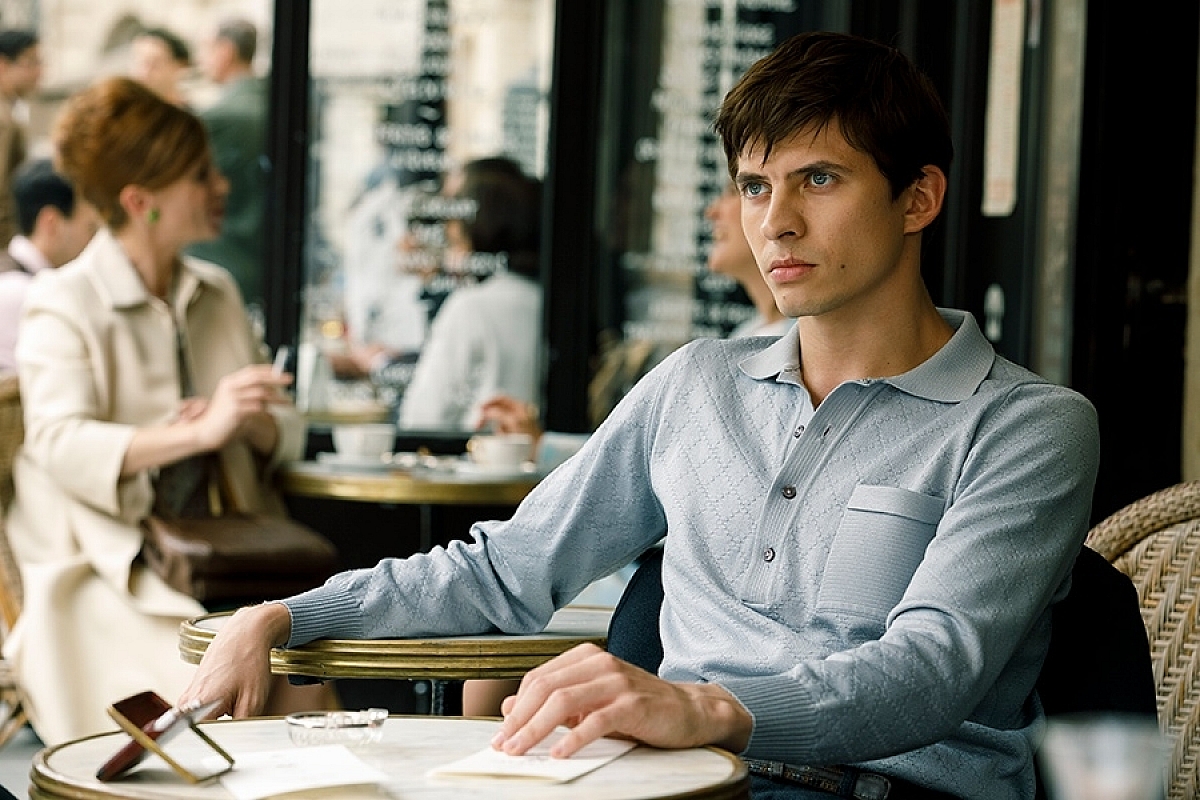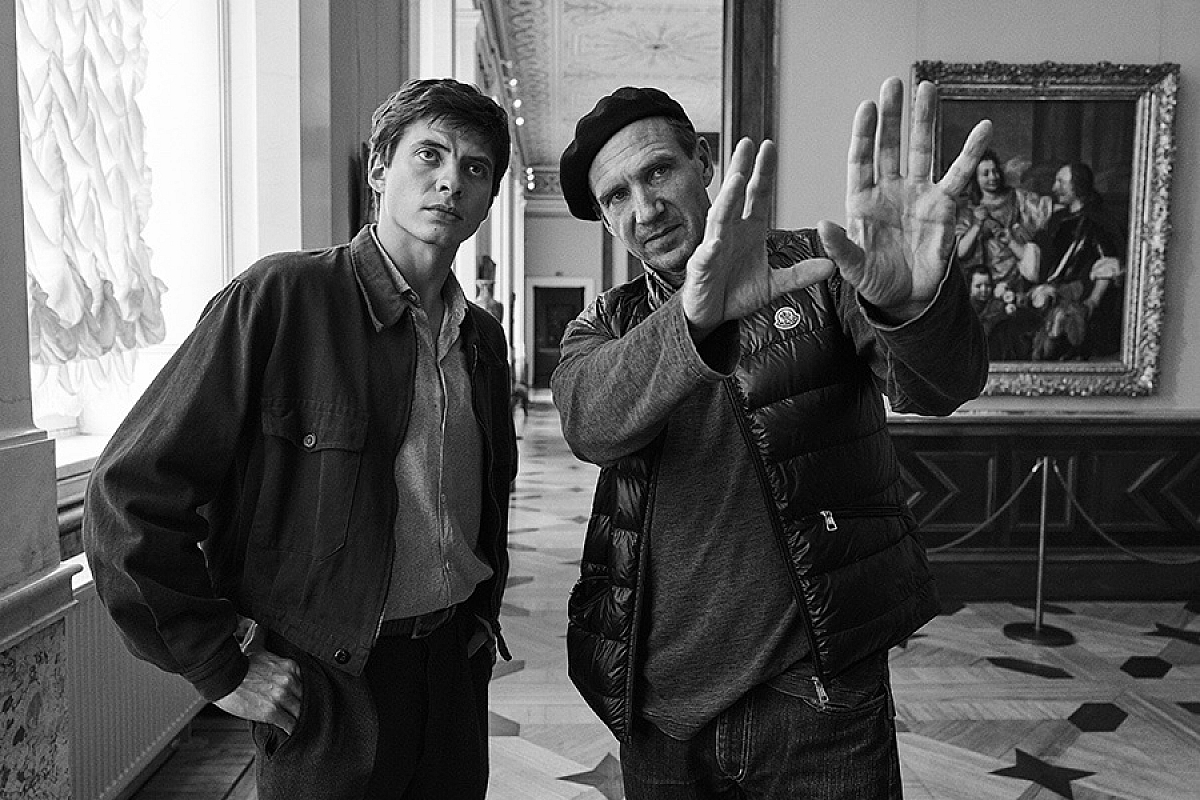DP Mike Eley BSC used Super 16mm to evoke the spirit-of-the-age for 'The White Crow'

Oleg Ivenko stars as Rudolf Nureyev in "The White Crow", shot in Super 16mm on Kodak. Photo credit: Jessica Forde.
Captured chiefly on Kodak Super 16mm, The White Crow depicts the audacious leap taken by ballet dancer Rudolph Nureyev as he dramatically defected from Soviet Russia during the Kirov Ballet’s 1961 tour to Paris.
The €15m feature was directed by Ralph Fiennes and shot by British cinematographer Mike Eley BSC. With this production, the pair joined a distinguished band of directors/DPs preferring to harness the innate, organic aesthetic of Super 16mm for the purpose of gripping and intimate storytelling. Landmark uses of Super 16mm include Todd Haynes and Ed Lachman ASC with Carol, Darren Aronofsky and Matthew Libatique ASC for Black Swan and Mother!, plus Kathryn Bigelow and Barry Ackroyd BSC for The Hurt Locker.

Director Ralph Fiennes (right) with Oleg Ivenko (left), who plays Rudolph Nureyev, in "The White Crow", shot in Super 16mm on Kodak.
The White Crow is Fiennes’s third feature as a director, following Coriolanus (2011) and The Invisible Woman (2014), which were both shot on 35mm film. Scripted by David Hare and informed by Julie Kavanagh’s 2007 book Rudolph Nureyev: The Life, the film depicts Nureyev’s five-week visit to Paris, dancing with the Kirov Ballet. Aged just 23, this was his first trip to the West.
Nureyev was both beckoned and beguiled by the city’s art, culture and glittering nightlife, much to the irritation of his KGB minders, who watched his every step on and off-stage. During the film, Nureyev’s Parisian adventures are intercut with scenes from his poverty-stricken childhood during the 1940s, and his vibrant life in Leningrad as an up-and-coming member of the renowned Kirov company. The movie’s title originates from the moniker Nureyev was given back then for his rather skeletal frame.
“As a cinematographer, you always have to think about the best way to carry a story, and the best outcome for the look of your production,” says Eley. “When you are shooting a period film, you’re looking to capture the spirit-of-the-age, to create a subtle or nuanced nod to an era. I believed film, especially Super 16mm, would best capture the spirit of Nureyev’s life, and particularly Paris in 1961. Thankfully, Ralph and the producers were of like mind about shooting on film, and they fully embraced the idea of capturing this story on Super 16mm.”
The White Crow stars Ukrainian ballet dancer Oleg Ivenko as Nureyev; the award-winning actress Adele Exarchopoulos as the wealthy aristocrat Clara Saint, who took Nureyev under her wing in Paris; whilst Fiennes plays Nureyev’s mentor and ballet master Alexander Pushkin.
The production shot on location in Paris, at a theatre in Croatia and studios in Belgrade, Serbia, as well as in St Petersburg (formerly Leningrad) and Ufa, Kazakhstan, Nureyev’s childhood home. Nureyev was born on a Trans- Siberian railway train near Irkutsk, Siberia – also depicted in the film – as his mother was travelling to Vladivostok, where his father, a Red Army political commissar, was billeted.
Due to the availability of actors and the logistics of travelling between locations, production took place over several stints between August 2017 and January 2018. While Eley would have preferred to have shot the entire production on film, the orchestration of the Russian phases of the production, where the shoot encompassed heritage sites such as the Hermitage Museum, meant having to shoot digitally.
“What was immediately interesting about the script, and the first jumping-off-point for Ralph and myself, was the non-linear timeline in the story,” says Eley. “The film predominantly takes place in Paris in the summer of 1961 but also takes in Nureyev’s unusual birth, impoverished childhood and the time he spent training as a ballet dancer in Leningrad.
“So, early on, Ralph and I discussed how best to create visual cues for the audience to follow these different parts of the story. After considering photographic stills and films from the French New Wave, we both decided on a grounded, not overly-saturated color palette, combined with exploratory handheld camerawork, to both evoke that era in Paris and to convey Nureyev’s excitement at being there.”
He continues, “As for our Russian sequences, there’s a tendency to depict the Soviet world as dour and grey. But there was actually a lot of color in people’s homes and in cities. We wanted that to be vibrant and strong, but with very deliberate, composed and controlled framing to mirror the exactitude of Nureyev’s ballet training.”
To distinguish Nureyev’s birth and early childhood, Fiennes and Eley went for a much more stripped-down look and switched the framing to widescreen. But Eley notes, “whatever the time period, our instinct was to keep the lighting naturalistic, and we went with available light, supplemented by practicals as often as we could.”
Operating himself, Eley shot The White Crow with ARRI 416 16mm cameras, using Cooke S4 and Angenieux Optimo zoom lenses for the Parisian and Russian portions of the story. Nureyev’s locomotive birth and early childhood sequences were shot and framed in Anamorphic. “The intention was to lend Nureyev’s early days an epic feel. The boy came from an age of tumult and courage,” he remarks.
Eley went with KODAK VISION3 500T Color Negative Film 7219 plus VISION3 200T Color Negative Film 7213 for the main body of shoot – accounting for over 80% of the movie’s screen time. All film processing on The White Crow was completed at Cinelab in London.
“To support our visual strategy, I decided to shoot all of the Parisian sequences using the 500T and all of the Leningrad scenes with the 200T,” says Eley. “I know both stocks really well and over-exposed them marginally by about a third of a stop. This yielded a slightly denser negative that would firstly give a lovely overall texture by mitigating against too much grain, and secondly, could also be manipulated in the final DI grade. The 500T and 200T are both great on skin tones, especially on the close-ups of our beautiful, fresh-faced leads. They match up well in terms of textural consistency too, although the looks we achieved were dramatically different.”
Plumbing the depths about the virtues of his selected stocks Eley says, “The 500T has always been incredibly giving and forgiving in its response to the light. Dependent on your exposure, it gives you a lot of scope to pull details from the shadows, such as the wings of the theatre stages during the different dance routines or highlight areas such as windows and the twinkling lights of the Parisian brasseries. It’s truly amazing what it can capture, and that gives you great confidence as you shoot.
“Likewise, the 200T is very solid, and I knew I could rely on it to convey the heft and color of Soviet life with which we wanted to imbue the image. It’s also incredibly responsive in low-light situations, with a particular richness in the blacks.”
Eley concludes: “In terms of execution, filming on film gives you an adrenaline shot and a rush of excitement on the set – everyone is so focused on their performances and getting their contribution right. And that’s very much to the benefit of the production.
“But what I also love about film, and Super 16mm in particular, is the instant texture and color-depth that you really only really get with celluloid. It can be such a fight sometimes to palliate the harshness of the digital sensor. As a storytelling format, Super 16mm is just so beautiful, and certainly helped Ralph and me arrive at the spirit-of-the-age from the get-go. Super 16mm has supported some of the finest filmmaking and storytelling you can see, and I wish it could be seen more often.”